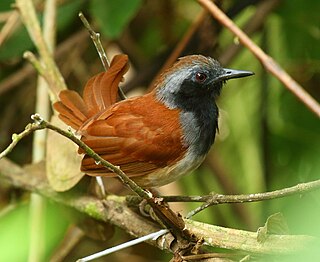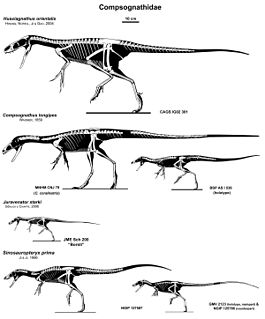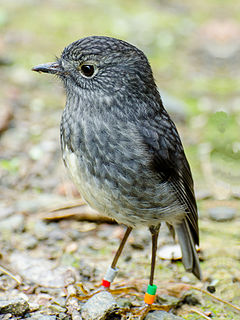Related Research Articles

Compsognathus is a genus of small, bipedal, carnivorous theropod dinosaur. Members of its single species Compsognathus longipes could grow to around the size of a turkey. They lived about 150 million years ago, during the Tithonian age of the late Jurassic period, in what is now Europe. Paleontologists have found two well-preserved fossils, one in Germany in the 1850s and the second in France more than a century later. Today, C. longipes is the only recognized species, although the larger specimen discovered in France in the 1970s was once thought to belong to a separate species and named C. corallestris.

The bushwren, bush wren, or mātuhituhi in Māori, was a very small and almost flightless bird that was endemic to New Zealand. It had three subspecies on each of the major islands of New Zealand, the North Island, South Island, and Stewart Island and nearby smaller islands. The species disappeared gradually after the introduction of invasive mammalian predators, last being seen on the North Island in 1955 and the South Island in 1968. Attempts were made to save the remaining population on small islands off Stewart Island, but they ultimately failed with the death of the last remaining known birds in 1972.

The white-bellied antbird, is a passerine bird which breeds in the tropical New World from Panama to northern Brazil and in Trinidad. It is also called Swainson's antcatcher after William John Swainson, who first described it scientifically. The genus is monotypic.

Compsognathidae is a family of coelurosaurian theropod dinosaurs. Compsognathids were small carnivores, generally conservative in form, hailing from the Jurassic and Cretaceous Periods. The bird-like features of these species, along with other dinosaurs such as Archaeopteryx inspired the idea for the connection between dinosaur reptiles and modern-day avian species. Compsognathid fossils preserve diverse integument — skin impressions are known from four genera commonly placed in the group, Compsognathus, Sinosauropteryx, Sinocalliopteryx, and Juravenator. While the latter three show evidence of a covering of some of the earliest primitive feathers over much of the body, Juravenator and Compsognathus also show evidence of scales on the tail or hind legs. Ubirajara, described in 2020, had elaborate integumentary structures on its back and shoulders superficially similar to the display feathers of a standardwing bird-of-paradise, and unlike any other non-avian dinosaur currently described.

Discoplax longipes is a species of terrestrial crab. It is found in karstic caves on Pacific islands and ranges from the Loyalty Islands to French Polynesia. Mating occurs in the caves, after which the females migrate to the sea to release their fertilised eggs. The genus Discoplax was for a long time synonymised with Cardisoma, but was resurrected in the late 20th century.

The long-footed potoroo is a small marsupial found in southeastern Australia, restricted to an area around the coastal border between New South Wales and Victoria. It was first recorded in 1967 when an adult male was caught in a dog trap in the forest southwest of Bonang, Victoria. It is classified as vulnerable.
The Kashmir cave bat is a species of vesper bat. It is endemic to the Western Himalayas of South Asia. It is found in the Western Himalayan broadleaf forests ecoregion, within Bhutan, India, Nepal, Pakistan, and Afghanistan.
The big-eared swamp rat is a species of rodent in the family Muridae. It is found in Angola, Cameroon, Central African Republic, Republic of the Congo, Democratic Republic of the Congo, Equatorial Guinea, Gabon, Nigeria, Uganda, and Zambia. Its natural habitat is subtropical or tropical moist lowland forests.

The long-footed treeshrew is a treeshrew species within the Tupaiidae. It is endemic to Borneo and threatened due to deforestation and degradation of habitat.

The Savanna swamp shrew is a species of mammal in the family Soricidae. It is endemic to Nigeria. Its natural habitat is swamps. It is threatened by habitat loss.

The North Island robin is a species of Australasian robin endemic to the North Island of New Zealand. It and the South Island robin of the South Island and Stewart Island were once considered conspecific, but mitochondrial DNA sequences have shown that the two lineages split prior to the Pleistocene, and support the classification as two different species.
Erythrochampsa is an extinct genus of protosuchian crocodylomorph. Fossils have been found from the Red Beds of the Stormberg Group, the youngest group of strata from the Karoo Supergroup outcropping in South Africa.

Libo County is a county of southern Guizhou province, China, bordering Guangxi to the south. It is under the administration of the Qiannan Buyei and Miao Autonomous Prefecture.

Stegomosuchus is an extinct genus of small protosuchian crocodylomorph. It is known from a single incomplete specimen discovered in the late 19th century in Lower Jurassic rocks of south-central Massachusetts, United States. It was originally thought to be a species of Stegomus, an aetosaur, but was eventually shown to be related to Protosuchus and thus closer to the ancestry of crocodilians. Stegomosuchus is also regarded as a candidate for the maker of at least some of the tracks named Batrachopus in the Connecticut River Valley.
Anthracodromeus is an extinct genus of Late Carboniferous protorothyridid known from Ohio. It is known from the holotype AMNH 6940, a nearly complete skeleton. It was collected in the Linton site in Jefferson County, from the upper Freeport Coal Member. A. longipes was first assigned by Edward Drinker Cope in 1875 to a species of Sauropleura. The genus was first named by Robert L. Carroll and Donald Baird in 1972 and the type species is Anthracodromeus longipes.

Panulirus longipes, the longlegged spiny lobster, is a species of spiny lobster that lives on shallow rocky and coral reefs in the tropical Indo-Pacific region. The International Union for Conservation of Nature has assessed its conservation status as being of "least concern".
Nedine adversa is a species of beetle in the family Cerambycidae. It was described by Pascoe in 1864. It is known from Java, Malaysia, Borneo and Sumatra.
Nedine spaethi is a species of beetle in the family Cerambycidae. It was described by Heller in 1924.
Nedine sparatis is a species of beetle in the family Cerambycidae. It was described by Wang and Chiang in 1999.
Nedine subspinosa is a species of beetle in the family Cerambycidae. It was described by Wang and Chiang in 1999.
References
- ↑ BioLib.cz - Nedine longipes. Retrieved on 8 September 2014.